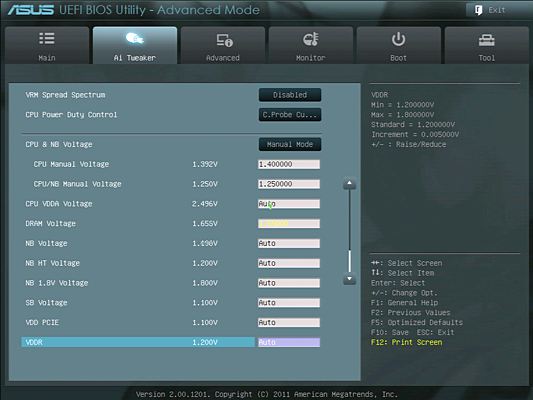Five $160 To $240 990FX-Based Socket AM3+ Motherboards
Forty-two PCIe lanes give the 990FX a clear connectivity lead over competing Intel chipsets. We compare five class-leading products using AMD's FX-8150 to see which offers the best combination of performance, overclocking, integrated features, and value.
Sabertooth 990FX Firmware
Although it was the GUI that often scared new overclockers away from the BIOS, underlying limitations of that technology were the driving force behind Asus’ switch to UEFI. Nevertheless, we enjoy and appreciate the BIOS-like simplicity of the Sabertooth 990FX's UEFI interface.
Spanning three pages, Asus’ Ai Tweaker menu provides a wide range of clock and voltage controls that, unlike those of many competitors, actually work in a predictable manner. For example, when we disabled AMD Turbo Core to stability-test our maximum continuous overclock, the Sabertooth 990FX actually locked in the speed we set.
A little experimentation with Asus’ multi-stage Load Line Calibration revealed that the “High” setting kept our overclocked CPU very close to the continuous voltage we desired.
Asus-specific features are primarily limited to operational modes for its PWM, though all of the expected CPU, DRAM, and chipset voltage settings are also available.


Primary, secondary, and tertiary memory timings are individually selectable from Ai Tweaker’s DRAM Timing Control submenu.
Get Tom's Hardware's best news and in-depth reviews, straight to your inbox.
-
timbo1130 How is this relevant to enthusiast? Bulldozer is out classed by Sandy Bridge I don't care if there are a few less sata ports. If you need to upgrade your better off going with Sandy bridge and z68 or p67 or wait for SB-E and X79.Reply -
julianbautista87 thanks for this article. I was waiting for it since some guy said that the 8150 was performing badly because of the mainboard used, but now I see that that was not correct.Reply -
_Pez_ Yeah If were to buy this boards would be with a Phenom real 6 core CPU 1100T :D that is the smartest choice. I think.Reply -
frostweaver I would wait till next year to decide. I still feel that windows 7 aint optimized for BD.Reply -
Tijok First off, thanks for the great article, good to see Tom's is keeping up the top notch quality!Reply
Secondly, I would really like to see a piece on extreme CFX/SLI configurations on rigs like this. It seems an article with reliable information on this would be beneficial to gaming enthusiasts, IT professionals, and HPC builders alike!
Hope to see an article along these lines soon! -
palladin9479 I bought the Sabertooth during the summer and I can attest to how amazing that board is. It's really nice, lots of features and high quality. I'm running a Phenom II X4 970BE @ 4.3Ghz on water right now. Absolutely wonderful system.Reply -
ta152h What a bunch of pretzel logic we have in this article.ReplyOf course, a fan of Intel's work could argue against the need for 42 lanes of second-gen PCIe when the 36 native to X58 Express support multi-card graphics configurations just as capably. But such a comparison really isn't necessary. After all, we've known for almost a year that Intel’s lower-cost Sandy Bridge-based part outperform the pricey six-core Gulftown-based processors in many desktop benchmarks, including pretty much every gaming scenario we throw at the two platforms.
So, x58 is irrelevant, because SB beats it. Except AMD's offering is somehow relevant even though both x58 and SB beat it. What?????
If you ignore x58 because SB offers better performance, you ignore anything AMD has because a SB setup offers better performance. If you want 36 or less lanes, x58 still offers better processors than you can hope to get from AMD. Bizarre logic.
Not that AMD is irrelevant, just the logic is badly flawed.



